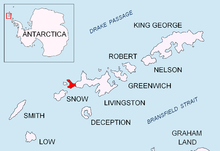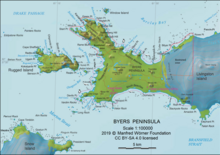
Svishtov Cove is a 2.19 km wide cove indenting for 1.48 km the northwest extremity of Ray Promontory on Byers Peninsula, Livingston Island in the South Shetland Islands, Antarctica. it is entered southwest of Essex Point and northeast of Start Point.

Start Point is a point marking the northwest end of Byers Peninsula, Livingston Island in the South Shetland Islands, Antarctica and forming the southwest side of the entrance to Svishtov Cove and the northeast side of the entrance to the New Plymouth bay. Discovered by Edward Bransfield in January 1820, and so named by him because of its resemblance to a point on the south coast of England by the same name and because it was the place where his operations began.

Bakshev Ridge is a rugged rocky ridge on Rugged Island off the west coast of Byers Peninsula of Livingston Island in the South Shetland Islands, Antarctica extending 700 m in southeast-northwest direction, with a highest point of elevation 239 m situated 660 m east of San Stefano Peak, 1.25 km west of Vund Point, and 1.1 km northwest of Radev Point.

San Stefano Peak is a rocky peak rising to 256 m, the summit of Rugged Island off the west coast of Byers Peninsula of Livingston Island in the South Shetland Islands, Antarctica. Situated in the central part of the island, 3.48 km northeast of Benson Point, 4.17 km southeast of Cape Sheffield, 830 m south of Cherven Peak, 1.91 km west of Vund Point, and 1.58 km northwest of Radev Point.

Ivan Vladislav Point is a point on the north coast of Rugged Island off the west coast of Byers Peninsula of Livingston Island in the South Shetland Islands, Antarctica formed by an offshoot of Cherven Peak. Situated 1.63 km west-northwest of Herring Point, 400 m east-northeast of Simitli Point, and 3.27 km east-southeast of Cape Sheffield.

Vund Point is the point forming the east extremity of Rugged Island off the west coast of Byers Peninsula of Livingston Island in the South Shetland Islands, Antarctica. The area was visited by early 19th century sealers.

Dometa Point is a point in the middle part of South Beaches on Byers Peninsula, Livingston Island in the South Shetland Islands, Antarctica. It is situated 4.3 km west-northwest of Rish Point, 1.2 km southwest of Negro Hill, 4.6 km southeast of Chester Cone, and 4.2 km east-northeast of Nikopol Point. Fontus Lake is centred 600 m northeast of the point.

Tsamblak Hill is a rocky hill trending 900 m in north-south direction, 450 m wide and rising to 113 m in eastern Byers Peninsula on Livingston Island in the South Shetland Islands, Antarctica. It surmounts Bedek Stream on the east, Feya Tarn on the south-southwest and Eridanus Stream on the west.

Dulo Hill is a rocky hill rising to 210 m (690 ft) in Dospey Heights on Byers Peninsula of Livingston Island in the South Shetland Islands, Antarctica. It overlooks President Beaches to the south.

Essex Point is a point at the northwest end of Byers Peninsula, Livingston Island in the South Shetland Islands, Antarctica. It forms the west side of the entrance to Barclay Bay and the northeast side of the entrance to Svishtov Cove, and is surmounted by Drong Hill.

Midge Lake is the largest among numerous freshwater lakes on the ice-free Byers Peninsula, Livingston Island in the South Shetland Islands, Antarctica. The feature is arcuate in shape, extending 575 m in southwest-northeast direction and 125 m wide, surmounted by Chester Cone on the southeast, and draining through a 2 km stream north-northeastwards into Baba Tonka Cove.

Lair Point is a point projecting 570 m into Barclay Bay from Robbery Beaches on Byers Peninsula, Livingston Island in the South Shetland Islands, Antarctica and forming the east side of the entrance to Kukuzel Cove. Dominated by Lair Hill.

Point Smellie is a small steep-sided headland extending into Osogovo Bay from President Beaches on Byers Peninsula, Livingston Island in the South Shetland Islands, Antarctica and dominated by Smellie Hill.

Laager Point is a conspicuous headland extending out from President Beaches on Byers Peninsula, Livingston Island in the South Shetland Islands, Antarctica facing Astor Island. It forms the southeast entrance point for New Plymouth harbour and the northeast entrance point for Osogovo Bay. Naiad Lake is situated on the southwest side of the point and Pistiros Lake is centred 900 m east of it. The area was visited by 19th century sealers.

Ocoa Point is a steep headland backed by raised beach terraces at the head of New Plymouth harbour in Byers Peninsula, Livingston Island in the South Shetland Islands, Antarctica. The area was visited by 19th century sealers.

Negro Hill is a conspicuous rocky hill, double-peaked with a small tarn in between, rising to 100 m at South Beaches on Byers Peninsula, Livingston Island in the South Shetland Islands, Antarctica. It surmounts Fontus Lake on the south. The area was visited by 19th-century sealers.

Usnea Plug is a volcanic plug, 30 m from base to summit, rising to 117 m in the interior of Byers Peninsula, Livingston Island in the South Shetland Islands, Antarctica. The area was known to 19th century sealers.

Sealer Hill is a hill rising to 70 m in the southwest part of Byers Peninsula, Livingston Island in the South Shetland Islands, Antarctica. It surmounts Nikopol Point and Sevar Point to the east-southeast and west-southwest, respectively. The area was inhabited by 19th century sealers.

Wasp Hill is a hill rising to 72 meters in the southwest part of Byers Peninsula, Livingston Island in the South Shetland Islands, Antarctica. Surmounting Sevar Point to the south-southwest. The area was visited by 19th century sealers.

Camp Livingston is an Argentine seasonal base camp on Byers Peninsula, Livingston Island in the South Shetland Islands, Antarctica. The area was visited by early 19th century sealers.




